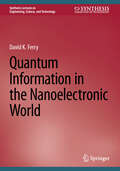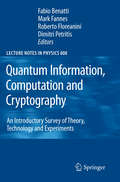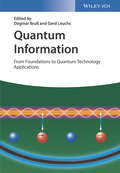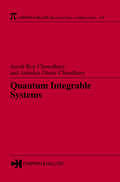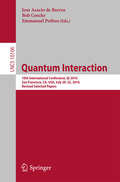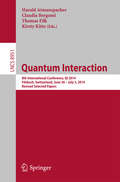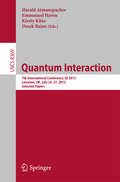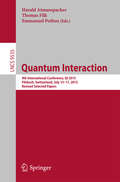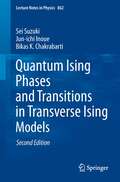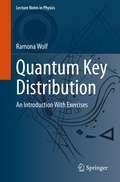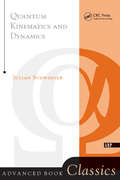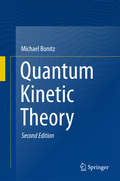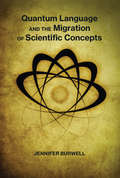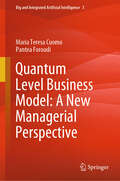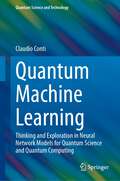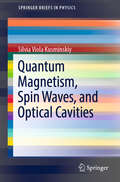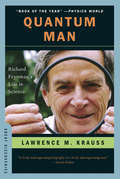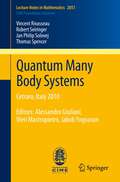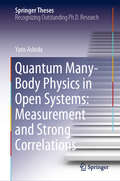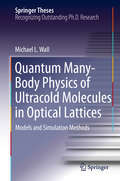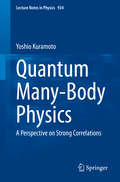- Table View
- List View
Quantum Information in the Nanoelectronic World (Synthesis Lectures on Engineering, Science, and Technology)
by David K. FerryThis book provides a concise introduction to quantum information and quantum science. The author discusses in language accessible to a broad audience, the why and how, as well as implementation technologies. The discussion includes coverage of general computing (e.g., Turing ideas) for comparison, and ideas like entropy and minimum dissipation. Topics such as quantum communications and quantum sensing enhance the discussion of quantum computing. In addition, the manner in which entanglement is used in each of these sub-fields is addressed with applications and, for example, a discussion of the quantum Fourier transform.
Quantum Information, Computation and Communication
by Jonathan A. Jones Dieter JakschQuantum physics allows entirely new forms of computation and cryptography, which could perform tasks currently impossible on classical devices, leading to an explosion of new algorithms, communications protocols and suggestions for physical implementations of all these ideas. As a result, quantum information has made the transition from an exotic research topic to part of mainstream undergraduate courses in physics. Based on years of teaching experience, this textbook builds from simple fundamental concepts to cover the essentials of the field. Aimed at physics undergraduate students with a basic background in quantum mechanics, it guides readers through theory and experiment, introducing all the central concepts without getting caught up in details. Worked examples and exercises make this useful as a self-study text for those who want a brief introduction before starting on more advanced books. Solutions are available online at www. cambridge. org/9781107014466.
Quantum Information, Computation and Cryptography
by Fabio Benatti Dimitri Petritis Mark Fannes Roberto FloreaniniThis multi-authored textbook addresses graduate students with a background in physics, mathematics or computer science. No research experience is necessary. Consequently, rather than comprehensively reviewing the vast body of knowledge and literature gathered in the past twenty years, this book concentrates on a number of carefully selected aspects of quantum information theory and technology. Given the highly interdisciplinary nature of the subject, the multi-authored approach brings together different points of view from various renowned experts, providing a coherent picture of the subject matter. The book consists of ten chapters and includes examples, problems, and exercises. The first five present the mathematical tools required for a full comprehension of various aspects of quantum mechanics, classical information, and coding theory. Chapter 6 deals with the manipulation and transmission of information in the quantum realm. Chapters 7 and 8 discuss experimental implementations of quantum information ideas using photons and atoms. Finally, chapters 9 and 10 address ground-breaking applications in cryptography and computation.
Quantum Information: From Foundations to Quantum Technology Applications
by Dagmar Bruss Gerd LeuchsThis comprehensive textbook on the rapidly advancing field introduces readers to the fundamental concepts of information theory and quantum entanglement, taking into account the current state of research and development. It thus covers all current concepts in quantum computing, both theoretical and experimental, before moving on to the latest implementations of quantum computing and communication protocols. It contains problems and exercises and is therefore ideally suited for students and lecturers in physics and informatics, as well as experimental and theoretical physicists in academia and industry who work in the field of quantum information processing.The second edition incorporates important recent developments such as quantum metrology, quantum correlations beyond entanglement, and advances in quantum computing with solid state devices.
Quantum Integrable Systems (Chapman And Hall/crc Research Notes In Mathematics Ser. #Vol. 435)
by Asesh Roy Chowdhury Aninlya Ghose ChoudhuryThe study of integrable systems has opened new horizons in classical physics over the past few decades, particularly in the subatomic world. Yet despite the field now having reached a level of maturity, very few books provide an introduction to the field accessible to specialists and nonspecialists alike, and none offer a systematic survey of the m
Quantum Interaction
by Emmanuel Pothos Bob Coecke Jose Acacio de BarrosThis book constitutes the thoroughly refereed post-conference proceedings of the 10th International Conference on Quantum Interaction, QI 2016, held in San Francisco, CA, USA, in July 2016. The 21 papers presented in this book were carefully reviewed and selected from 39 submissions. The papers address topics such as: Fundamentals; Quantum Cognition; Language and Applications; Contextuality and Foundations of Probability; and Quantum-Like Measurements.
Quantum Interaction
by Harald Atmanspacher Thomas Filk Claudia Bergomi Kirsty KittoThis book constitutes the refereed proceedings of the 8th International Conference on Quantum Interaction, QI 2014, held in Filzbach, Switzerland, in June/July 2014. The 19 papers together with 20 invited keynotes presented in this book were carefully selected from 22 submissions. Quantum Interaction has developed into an emerging interdisciplinary area of science combining research topics in fundamental issues, semantic and memory, decision making, games, politics and social aspects, non-locality and entanglement.
Quantum Interaction
by Emmanuel Haven Harald Atmanspacher Kirsty Kitto Derek RaineThis book constitutes the refereed proceedings of the 7th International Conference on Quantum Interaction, QI 2013, held in Leicester, UK, in July 2013. The 31 papers presented in this book were carefully selected from numerous submissions. The papers cover various topics on quantum interaction and revolve around four themes: information processing/retrieval/semantic representation and logic; cognition and decision making; finance/economics and social structures and biological systems.
Quantum Interaction
by Harald Atmanspacher Thomas Filk Emmanuel PothosThis book constitutes the thoroughly refereedpost-conference proceedings of the 9th International Conference on QuantumInteraction, QI 2015, held in Filzbach, Switzerland, in July 2015. The 20 papers together with 2 invited keynotes presentedin this book were carefully selected from 27 submissions. Quantum Interactionhas developed into an emerging interdisciplinary area of science combiningresearch topics in mathematics, physics, psychology, economics, cognitivescience, and computer science.
Quantum Interaction: 7th International Conference, QI 2013, Leicester, UK, July 25-27, 2013. Selected Papers (Lecture Notes in Computer Science #8369)
by Harald Atmanspacher, Emmanuel Haven, Kirsty Kitto and Derek RaineThis book constitutes the refereed proceedings of the 7th International Conference on Quantum Interaction, QI 2013, held in Leicester, UK, in July 2013. The 31 papers presented in this book were carefully selected from numerous submissions. The papers cover various topics on quantum interaction and revolve around four themes: information processing/retrieval/semantic representation and logic; cognition and decision making; finance/economics and social structures and biological systems.
Quantum Ising Phases and Transitions in Transverse Ising Models
by Bikas K. Chakrabarti Jun-Ichi Inoue Sei SuzukiQuantum phase transitions, driven by quantum fluctuations, exhibit intriguing features offering the possibility of potentially new applications, e.g. in quantum information sciences. Major advances have been made in both theoretical and experimental investigations of the nature and behavior of quantum phases and transitions in cooperatively interacting many-body quantum systems. For modeling purposes, most of the current innovative and successful research in this field has been obtained by either directly or indirectly using the insights provided by quantum (or transverse field) Ising models because of the separability of the cooperative interaction from the tunable transverse field or tunneling term in the relevant Hamiltonian. Also, a number of condensed matter systems can be modeled accurately in this approach, hence granting the possibility to compare advanced models with actual experimental results. This work introduces these quantum Ising models and analyses them both theoretically and numerically in great detail. With its tutorial approach the book addresses above all young researchers who wish to enter the field and are in search of a suitable and self-contained text, yet it will also serve as a valuable reference work for all active researchers in this area.
Quantum Key Distribution: An Introduction with Exercises (Lecture Notes in Physics #988)
by Ramona WolfThis textbook introduces the non-specialist reader to the concepts of quantum key distribution and presents an overview of state-of-the-art quantum communication protocols and applications. The field of quantum cryptography has advanced rapidly in the previous years, not least because with the age of quantum computing drawing closer, traditional encryption methods are at risk.The textbook presents the necessary mathematical tools without assuming much background, making it accessible to readers without experience in quantum information theory. In particular, the topic of classical and quantum entropies is presented in great detail. Furthermore, the author discusses the different types of quantum key distribution protocols and explains several tools for proving the security of these protocols. In addition, a number of applications of quantum key distribution are discussed, demonstrating its value to state-of-the-art cryptography and communication. This book leads the reader through the mathematical background with a variety of worked-out examples and exercises. It is primarily targeted at graduate students and advanced undergraduates in theoretical physics. The presented material is largely self-contained and only basic knowledge in quantum mechanics and linear algebra is required.
Quantum Kinematics And Dynamic (Advanced Book Program Ser.)
by Julian SchwingerA classic from 1969, this book is based on a series of lectures delivered at the Les Houches Summer School of Theoretical Physics in 1955. The book outlines a general scheme of quantum kinematics and dynamics.
Quantum Kinetic Theory
by Michael BonitzThis book presents quantum kinetic theory in a comprehensive way. The focus is on density operator methods and on non-equilibrium Green functions. The theory allows to rigorously treat nonequilibrium dynamics in quantum many-body systems. Of particular interest are ultrafast processes in plasmas, condensed matter and trapped atoms that are stimulated by rapidly developing experiments with short pulse lasers and free electron lasers. To describe these experiments theoretically, the most powerful approach is given by non-Markovian quantum kinetic equations that are discussed in detail, including computational aspects.
Quantum Language and the Migration of Scientific Concepts
by Jennifer BurwellHow highly abstract quantum concepts were represented in language, and how these concepts were later taken up by philosophers, literary critics, and new-age gurus. The principles of quantum physics—and the strange phenomena they describe—are represented most precisely in highly abstract algebraic equations. Why, then, did these mathematically driven concepts compel founders of the field, particularly Erwin Schrödinger, Niels Bohr, and Werner Heisenberg, to spend so much time reflecting on ontological, epistemological, and linguistic concerns? What is it about quantum concepts that appeals to latter-day Eastern mystics, poststructuralist critics, and get-rich-quick schemers? How did their interpretations and misinterpretations of quantum phenomena reveal their own priorities? In this book, Jennifer Burwell examines these questions and considers what quantum phenomena—in the context of the founders' debates over how to describe them—reveal about the relationship between everyday experience, perception, and language. Drawing on linguistic, literary, and philosophical traditions, Burwell illuminates representational and linguistic problems posed by quantum concepts—the fact, for example, that quantum phenomena exist only as probabilities or tendencies toward being and cannot be said to exist in a particular time and place. She traces the emergence of quantum theory as an analytic tool in literary criticism, in particular the use of wave/particle duality in interpretations of gender differences in the novels of Virginia Woolf and critics' connection of Bohr's Principle of Complementarity to poetic form; she examines the “quantum mysticism” of Fritjof Capra and Gary Zukav; and she concludes by analyzing “nuclear discourse” in the context of quantum concepts, arguing that it, too, adopts a language of the unthinkable and the indescribable.
Quantum Legacies: Dispatches from an Uncertain World
by David KaiserThe ideas at the root of quantum theory remain stubbornly, famously bizarre: a solid world reduced to puffs of probability; particles that tunnel through walls; cats suspended in zombielike states, neither alive nor dead; and twinned particles that share entangled fates. For more than a century, physicists have grappled with these conceptual uncertainties while enmeshed in the larger uncertainties of the social and political worlds around them, a time pocked by the rise of fascism, cataclysmic world wars, and a new nuclear age. In Quantum Legacies, David Kaiser introduces readers to iconic episodes in physicists’ still-unfolding quest to understand space, time, and matter at their most fundamental. In a series of vibrant essays, Kaiser takes us inside moments of discovery and debate among the great minds of the era—Albert Einstein, Erwin Schrödinger, Stephen Hawking, and many more who have indelibly shaped our understanding of nature—as they have tried to make sense of a messy world. Ranging across space and time, the episodes span the heady 1920s, the dark days of the 1930s, the turbulence of the Cold War, and the peculiar political realities that followed. In those eras as in our own, researchers’ ambition has often been to transcend the vagaries of here and now, to contribute lasting insights into how the world works that might reach beyond a given researcher’s limited view. In Quantum Legacies, Kaiser unveils the difficult and unsteady work required to forge some shared understanding between individuals and across generations, and in doing so, he illuminates the deep ties between scientific exploration and the human condition.
Quantum Level Business Model: A New Managerial Perspective (Big and Integrated Artificial Intelligence #3)
by Pantea Foroudi Maria Teresa CuomoEmbracing complexity as an opportunity, this groundbreaking book introduces Quantum Level Management—an agile, probabilistic, and interconnected approach to business. By applying principles from Quantum Science, it offers a radically new framework for strategic planning, decision-making, and organizational design. A key contribution is its ambidextrous logic: the ability to balance structure with flexibility, control with creativity, and stability with innovation. A dedicated section explores real-world applications in financial markets, a critical arena for testing and advancing Quantum Technologies. With critical insights, practical tools, and compelling case studies, this book empowers students, scholars, executives, and entrepreneurs to navigate an uncertain and dynamic quantum environment.
Quantum Lie Theory
by Vladislav KharchenkoThis is an introduction to the mathematics behind the phrase "quantum Lie algebra". The numerous attempts over the last 15-20 years to define a quantum Lie algebra as an elegant algebraic object with a binary "quantum" Lie bracket have not been widely accepted. In this book, an alternative approach is developed that includes multivariable operations. Among the problems discussed are the following: a PBW-type theorem; quantum deformations of Kac--Moody algebras; generic and symmetric quantum Lie operations; the Nichols algebras; the Gurevich--Manin Lie algebras; and Shestakov--Umirbaev operations for the Lie theory of nonassociative products. Opening with an introduction for beginners and continuing as a textbook for graduate students in physics and mathematics, the book can also be used as a reference by more advanced readers. With the exception of the introductory chapter, the content of this monograph has not previously appeared in book form.
Quantum Machine Learning: Thinking and Exploration in Neural Network Models for Quantum Science and Quantum Computing (Quantum Science and Technology)
by Claudio ContiThis book presents a new way of thinking about quantum mechanics and machine learning by merging the two. Quantum mechanics and machine learning may seem theoretically disparate, but their link becomes clear through the density matrix operator which can be readily approximated by neural network models, permitting a formulation of quantum physics in which physical observables can be computed via neural networks. As well as demonstrating the natural affinity of quantum physics and machine learning, this viewpoint opens rich possibilities in terms of computation, efficient hardware, and scalability. One can also obtain trainable models to optimize applications and fine-tune theories, such as approximation of the ground state in many body systems, and boosting quantum circuits’ performance. The book begins with the introduction of programming tools and basic concepts of machine learning, with necessary background material from quantum mechanics and quantum information also provided. This enables the basic building blocks, neural network models for vacuum states, to be introduced. The highlights that follow include: non-classical state representations, with squeezers and beam splitters used to implement the primary layers for quantum computing; boson sampling with neural network models; an overview of available quantum computing platforms, their models, and their programming; and neural network models as a variational ansatz for many-body Hamiltonian ground states with applications to Ising machines and solitons. The book emphasizes coding, with many open source examples in Python and TensorFlow, while MATLAB and Mathematica routines clarify and validate proofs. This book is essential reading for graduate students and researchers who want to develop both the requisite physics and coding knowledge to understand the rich interplay of quantum mechanics and machine learning.
Quantum Magnetism, Spin Waves, and Optical Cavities (SpringerBriefs in Physics)
by Silvia Viola KusminskiyThis primer thoroughly covers the fundamentals needed to understand the interaction of light with magnetically ordered matter and it focuses on "cavity optomagnonics" which is a topic undergoing intense study in current research.The book is unique in combining elements of electromagnetism, quantum magnetism, and quantum optics and it is intended for advanced undergraduate or graduate students.
Quantum Man: Richard Feynman's Life In Science (Great Discoveries #0)
by Lawrence M. Krauss"A worthy addition to the Feynman shelf and a welcome follow-up to the standard-bearer, James Gleick's Genius." --Kirkus Reviews Perhaps the greatest physicist of the second half of the twentieth century, Richard Feynman changed the way we think about quantum mechanics, the most perplexing of all physical theories. Here Lawrence M. Krauss, himself a theoretical physicist and a best-selling author, offers a unique scientific biography: a rollicking narrative coupled with clear and novel expositions of science at the limits. From the death of Feynman's childhood sweetheart during the Manhattan Project to his reluctant rise as a scientific icon, we see Feynman's life through his science, providing a new understanding of the legacy of a man who has fascinated millions.
Quantum Many Body Systems
by Vieri Mastropietro Jakob Yngvason Vincent Rivasseau Jan Philip Solovej Thomas Spencer Alessandro Giuliani Robert SeiringerThe book is based on the lectures given at the CIME school "Quantum many body systems" held in the summer of 2010. It provides a tutorial introduction to recent advances in the mathematics of interacting systems, written by four leading experts in the field: V. Rivasseau illustrates the applications of constructive Quantum Field Theory to 2D interacting electrons and their relation to quantum gravity; R. Seiringer describes a proof of Bose-Einstein condensation in the Gross-Pitaevski limit and explains the effects of rotating traps and the emergence of lattices of quantized vortices; J.-P. Solovej gives an introduction to the theory of quantum Coulomb systems and to the functional analytic methods used to prove their thermodynamic stability; finally, T. Spencer explains the supersymmetric approach to Anderson localization and its relation to the theory of random matrices. All the lectures are characterized by their mathematical rigor combined with physical insights.
Quantum Many-Body Physics in Open Systems: Measurement and Strong Correlations (Springer Theses)
by Yuto AshidaThis book studies the fundamental aspects of many-body physics in quantum systems open to an external world. Recent remarkable developments in the observation and manipulation of quantum matter at the single-quantum level point to a new research area of open many-body systems, where interactions with an external observer and the environment play a major role. The first part of the book elucidates the influence of measurement backaction from an external observer, revealing new types of quantum critical phenomena and out-of-equilibrium dynamics beyond the conventional paradigm of closed systems. In turn, the second part develops a powerful theoretical approach to study the in- and out-of-equilibrium physics of an open quantum system strongly correlated with an external environment, where the entanglement between the system and the environment plays an essential role. The results obtained here offer essential theoretical results for understanding the many-body physics of quantum systems open to an external world, and can be applied to experimental systems in atomic, molecular and optical physics, quantum information science and condensed matter physics.
Quantum Many-Body Physics of Ultracold Molecules in Optical Lattices
by Michael L. WallThis thesis investigates ultracold molecules as a resource for novel quantum many-body physics, in particular by utilizing their rich internal structure and strong, long-range dipole-dipole interactions. In addition, numerical methods based on matrix product states are analyzed in detail, and general algorithms for investigating the static and dynamic properties of essentially arbitrary one-dimensional quantum many-body systems are put forth. Finally, this thesis covers open-source implementations of matrix product state algorithms, as well as educational material designed to aid in the use of understanding such methods.
Quantum Many-Body Physics: A Perspective on Strong Correlations (Lecture Notes in Physics #934)
by Yoshio KuramotoThis book offers a compact tutorial on basic concepts and tools in quantum many-body physics, and focuses on the correlation effects produced by mutual interactions.The content is divided into three parts, the first of which introduces readers to perturbation theory. It begins with the simplest examples—hydrogen and oxygen molecules—based on their effective Hamiltonians, and looks into basic properties of electrons in solids from the perspective of localized and itinerant limits. Readers will also learn about basic theoretical methods such as the linear response theory and Green functions. The second part focuses on mean-field theory for itinerant electrons, e.g. the Fermi liquid theory and superconductivity. Coulomb repulsion among electrons is addressed in the context of high-Tc superconductivity in cuprates and iron pnictides. A recent discovery concerning hydride superconductors is also briefly reviewed. In turn, the third part highlights quantum fluctuation effects beyond the mean-field picture. Discussing the dramatic renormalization effect in the Kondo physics, it provides a clear understanding of nonperturbative interaction effects. Further it introduces readers to fractionally charged quasi-particles in one and two dimensions. The last chapter addresses the dynamical mean field theory (DMFT).The book is based on the author’s long years of experience as a lecturer and researcher. It also includes reviews of recent focus topics in condensed matter physics, enabling readers to not only grasp conventional condensed matter theories but also to catch up on the latest developments in the field.
